Electric scooter safety tips are vital for anyone who rides these fun vehicles. Knowing how to stay safe matters more than ever.
Always wear a helmet, check your brakes and wheels before each ride, and know the basic traffic rules. Even a quick safety check can prevent nasty falls and injuries.
New to riding? Practice in empty parking lots before hitting busy streets. Whether you're a daily commuter or weekend rider, these simple habits can keep you safe while you zip around town.
Keep reading to learn how to enjoy your rides without the bruises!
Essential Safety Gear For Electric Scooter Riders
Wearing the right safety gear can protect you from injuries while riding an electric scooter. The right equipment keeps you safe and visible to others on the road.
Helmets And Protective Clothing
Always wear a helmet when riding your electric scooter. It's the most important piece of safety gear you can own.
Helmets protect your head in case you fall or crash. Pick one that fits well and has good ventilation.
Don't forget about other protective gear too! Elbow pads prevent scrapes and bruises if you fall. Wrist guards help protect your hands and wrists from sprains. Some riders also wear knee pads for extra protection.
Good shoes matter a lot. Wear closed-toe shoes with good grip. Flip-flops or sandals can get caught in your scooter and cause accidents.
Consider wearing gloves to improve your grip on handlebars. They also protect your hands if you fall.
In bad weather, use weather-resistant clothing to stay dry and comfortable.
Visibility Equipment And Lights
Being seen by others is super important when riding. Wear bright or reflective clothing so drivers can spot you easily. Reflective vests or jackets work great, especially at night.
Make sure your scooter has working front and rear lights. The front light helps you see the path ahead. The rear light lets others know where you are.
Add reflective tape to your scooter and helmet for extra visibility. Some riders use LED armbands or clip-on lights for even more visibility.
Don't forget a bell or horn! It helps you alert pedestrians when you're approaching. Check your lights before each ride to make sure they work properly.
Safety starts with having the right equipment for challenging terrain. Ready to tackle hills and rough roads safely? Check out Isinwheel's collection of dual motor electric scooters for better stability and control on your adventures.
Pre-Ride Safety Checks

Before hopping on your electric scooter, taking a few minutes to check it can prevent accidents and keep you safe. A quick inspection ensures everything works properly for a smooth ride.
Testing Brakes, Tires, And Battery
Always test your brakes before riding. Squeeze both brake levers to make sure they work well. Your scooter should stop quickly without making weird noises. If the brakes feel soft or don't stop you fast enough, don't ride until they're fixed.
Check your tire pressure with a gauge. Tires that are too soft make your scooter harder to control. Tires that are too hard might pop easily. Look at the side of your tire to find the right pressure number.
Test your battery level too! Make sure it has enough charge for your trip. A dead battery far from home is no fun. Most scooters have lights or an app that shows battery life.
Quick Maintenance Inspection
Look over your scooter for loose parts before each ride. Wiggle the handlebars to check if they're tight. Make sure the folding latch is locked if your scooter folds.
Inspect the frame for cracks or damage. Small problems can become big ones if ignored. Check that all lights work properly. Working lights help others see you, especially at night.
Simple Pre-Ride Checklist:
✓ Brake test (front and rear)
✓ Tire pressure and condition
✓ Battery charge level
✓ Secure folding mechanism
✓ Working lights and horn
✓ Tight screws and bolts
Clean your scooter regularly too. Dirt can hide problems or damage important parts. A quick wipe-down helps you spot issues early.
Safe Riding Techniques

Staying safe on an electric scooter depends on how well you control your ride. Good technique helps you avoid accidents and enjoy your trips without worry.
Proper Stance And Control
Stand with your feet shoulder-width apart, one foot slightly ahead of the other. This gives you better balance when you speed up or slow down. Keep your knees slightly bent to absorb bumps in the road.
Hold the handlebars firmly but not too tight. Squeezing too hard makes it harder to react quickly. Your arms should be relaxed with a slight bend at the elbows.
Practice smooth throttle control. Don't jerk the throttle - ease into acceleration. This prevents the scooter from lurching forward unexpectedly.
For braking, use both brakes when possible and start slowing down early. Sudden braking can make you lose control. Shift your weight backward slightly when braking to prevent tipping forward.
Turning tips:
- Lean gently in the direction you want to turn
- Look where you want to go, not at obstacles
- Slow down before entering turns, not during them
Navigating Traffic And Obstacles
Always scan the road ahead for potential hazards. Look at least 30 feet in front of you to spot problems early. This gives you time to react safely.
Signal your turns with hand gestures. Make eye contact with drivers when crossing their path. Never assume they see you!
When approaching obstacles like potholes or debris, slow down first. Go around them when possible rather than over them. If you must go over small obstacles, lift slightly off the deck by bending your knees.
Stay away from car doors that might open suddenly. Ride at least 3 feet from parked cars.
In busy areas, it's sometimes safer to hop off and walk your scooter. This is especially true in crowded pedestrian zones or complicated intersections.
Riding In Different Weather Conditions
Rain makes roads slippery. When it's wet, reduce your speed by at least 30%. Avoid painted lines, metal surfaces, and manhole covers as they become extra slick.
Leave more space for braking in wet conditions. Your stopping distance will be much longer than usual. Wind can push your scooter sideways.
In strong winds, lean slightly into the wind to maintain balance. Be extra careful when passing buildings where sudden gusts might surprise you.
Extreme heat can affect battery performance. On very hot days, take breaks to let your scooter cool down.
Cold weather reduces battery life. Your range might be shorter in winter. Wear gloves to keep your hands warm for better throttle and brake control.
Don't ride in snow, ice, or heavy rain if you can avoid it. These conditions make electric scooters extremely dangerous even for experienced riders.
Comfortable riding positions reduce fatigue and help you stay alert on longer trips. Want to combine safety with comfort? Explore Isinwheel's collection of electric scooters with seats and baskets for a secure, practical riding experience.
Electric Scooter Traffic Rules

When riding an electric scooter, you need to follow specific traffic rules to stay safe and legal. These rules help you avoid accidents and penalties while sharing space with cars and people walking.
Where To Ride Legally
You should always check your local laws before riding your electric scooter. Many cities only allow e-scooters on bike lanes or streets with speed limits under 25 mph. Some places don't want them on sidewalks at all!
Different areas have different rules. In some cities, you can ride in parks or on trails. In others, these places are off-limits.
Companies like Spin often have maps in their apps showing where you can ride. These maps also show no-ride zones and slow-speed areas.
Don't forget about parking! Most cities have rules about where you can leave your scooter. Bad parking can get you a ticket or fine.
Sharing Roads With Vehicles And Pedestrians
When riding with cars, you must follow the same traffic laws they do. Stop at red lights. Use hand signals before turning. Ride in the same direction as traffic.
Always yield to people walking. They have the right of way, especially at crosswalks. Use your bell to let others know you're coming, but don't expect them to move.
Keep a safe distance from cars. They might not see you, especially in blind spots. Be extra careful at intersections where most accidents happen.
Watch your speed! Most areas limit e-scooters to 15-20 mph. Slow down in crowded areas or bad weather. Remember, you're riding without the protection of a car around you.
Understanding how your accelerator works is crucial for maintaining control. Want to improve your acceleration technique for safer rides? Dive into A Guide to Different Types of Scooter Accelerators to enhance your riding precision.
Common Hazards and How To Avoid Them

Riding an electric scooter can be fun, but there are dangers you need to watch out for. Knowing what these hazards are can help keep you safe when you're zipping around town.
Surface Dangers (Potholes, Wet Areas)
Potholes can throw you off your scooter if you hit one. Always scan the road ahead while riding. Try to avoid streets that are in bad condition when you can.
Wet areas are super slippery for scooter wheels. After rain, puddles and wet leaves can make you slide and fall. If you must ride after rain, go slower than usual and avoid making sharp turns.
Cracks in the sidewalk might seem small, but they can catch your wheels. Sand and gravel are also tripping hazards that can make you lose control.
Tips for handling surface dangers:
- Keep both hands on the handlebars
- Bend your knees slightly to absorb bumps
- Slow down before crossing uneven surfaces
- Don't ride through puddles if you can go around them
Night Riding Precautions
Riding at night is much more dangerous than during the day. Other people on the road might not see you coming, which can lead to crashes.
Essential night riding gear:
- Wear bright or reflective clothing
- Use a headlamp on your helmet
- Make sure your scooter has working front and rear lights
- Consider adding extra reflective tape to your scooter and helmet
Always choose well-lit paths when riding after dark. Avoid shortcuts through dark areas, even if they save time.
Let others know you're coming by using a bell or horn. Many accidents happen because pedestrians don't hear electric scooters approaching.
Your eyes need time to adjust to darkness. Give yourself a few minutes before riding at full speed when going from bright to dark areas.
Parking And Security
Proper parking and keeping your scooter safe are key parts of electric scooter ownership. Following these guidelines will help protect your investment and avoid causing problems for others.
Safe Parking And Storage
Always park your electric scooter in designated areas. Look for bike racks or moped parking spots when available.
You should never park your scooter in places that block sidewalks, building entrances, or driveways. This creates hazards for pedestrians, especially those with disabilities.
When you reach your destination, remember to walk your scooter to the parking area rather than riding it on the sidewalk.
At home, store your scooter in a dry place away from extreme temperatures. Keeping it indoors is best when possible.
If you live in an apartment, check with your building manager about approved storage locations. Some buildings have special areas for scooters and bikes.
Theft Prevention
Electric scooters are valuable and can be targets for theft. Always lock your scooter, even if you'll only be away for a few minutes. Use a strong lock - preferably a U-lock or heavy chain lock.
Recommended security measures:
- Use two different types of locks for extra security
- Secure your scooter to fixed, immovable objects
- Lock through the frame, not just easily removable parts
- Consider a GPS tracker for your scooter
Remove detachable parts like batteries when possible. This makes your scooter less appealing to thieves and harder to use if stolen.
Many manufacturers now offer anti-theft features like alarms and remote locking. Check if your model has these options and learn how to use them properly.
Emergency Preparation
Even the most careful riders may face emergencies. Being ready for unexpected situations can make a big difference in how well you recover from accidents or injuries.
Handling Accidents
If you crash your electric scooter, first move to a safe spot away from traffic. Check yourself for injuries before checking your scooter.
Don't try to stand up right away if you feel dizzy or hurt. Call 911 if you or anyone else has serious injuries. For less serious crashes, take photos of the scene, your scooter, and any vehicles involved. This will help with insurance claims later.
Write down contact info from witnesses. They can help explain what happened if needed. Always report accidents to the police, even small ones. This creates an official record that might be important later.
If your scooter is damaged, don't ride it. Walking or calling for a ride is safer than using a broken scooter.
Basic First Aid For Scooter Riders
Carry a small first aid kit in your backpack or scooter storage. Include band-aids, antiseptic wipes, gauze pads, and pain relievers.
For scrapes and cuts, clean the wound with water or antiseptic wipes. Cover with a clean bandage to prevent infection.
Head injuries need special care. Look for warning signs like:
- Headache that gets worse
- Confusion or memory problems
- Blurry vision
- Nausea or vomiting
These symptoms might mean you need to visit an emergency room right away. For sprains, remember RICE: Rest, Ice, Compression, and Elevation. This helps reduce swelling and pain until you can see a doctor.
Wearing proper gear like helmets and pads can prevent many injuries in the first place. Being prepared isn't just about treating wounds—it's about preventing them too!
Maintenance For Safety
Taking care of your electric scooter is just as important as riding it safely. Regular upkeep prevents accidents and extends the life of your scooter.
Regular Safety Inspections
Check your brakes before every ride. Squeeze them to make sure they respond quickly. This simple test can save you from a crash! Look at your tires weekly for proper inflation and signs of wear.
Under-inflated tires make your scooter harder to control. Over-inflated ones can pop more easily. Your owner's manual will tell you the right pressure.
Battery checks are crucial too:
- Watch for any unusual smells
- Look for damage to the casing
- Make sure connections are tight
Inspect all screws and bolts monthly. Loose parts can cause dangerous rattling or even breakage while riding. A small wrench is all you need for this quick check.
Don't forget to test your lights and signals if your scooter has them. Good visibility keeps you safe, especially at night.
When To Seek Professional Service
Take your scooter to a pro if you notice strange noises or shaking. These could mean serious problems with the motor or frame. Don't ignore these warning signs!
Your owner's manual lists recommended service intervals. Usually, you'll need a checkup every 6-12 months depending on how much you ride. Mark these dates on your calendar.
Get help right away if:
- Your battery won't hold a charge
- Brakes feel weak or spongy
- Tires have deep cuts or bulges
Some repairs require special tools and knowledge. Trying to fix electrical issues yourself can be dangerous. The small cost of professional service is worth avoiding accidents.
Many shops offer safety inspections for less than a full service. This option is great if you're unsure about your scooter's condition before a long trip.
Well-maintained scooters are significantly safer on the road. Ready to prevent accidents before they happen? Discover our Comprehensive Guide to Electric Scooter Maintenance and Repair to keep your ride in peak safety condition.
Conclusion
Staying safe on an electric scooter isn't complicated—it just takes a bit of care and common sense. Wear your helmet, check your scooter before rides, follow traffic rules, and stay alert. These simple steps make a huge difference in preventing accidents and keeping your rides fun.
As you get more comfortable riding, don't let safety habits slip. Remember that cars may not always see you, wet roads can be slippery, and potholes appear when you least expect them. By sticking with these safety tips, you'll enjoy all the benefits of your electric scooter while keeping yourself—and others—safe on every trip.
Riding uphill safely requires proper technique and adequate power. Need to master hills without compromising safety? Read our complete guide Electric Scooter Uphill to learn essential skills for conquering inclines safely.
Frequently Asked Questions
What safety gear should I wear when riding an electric scooter?
Always wear a helmet when riding an electric scooter. It protects your head in case of falls or accidents.
Wrist guards, knee pads, and elbow pads provide extra protection for your joints. These are especially important for beginners. Wear closed-toe shoes with good grip. Flip-flops or sandals can be dangerous when riding.
Bright or reflective clothing helps drivers see you, which is super important at night or in bad weather.
How can I teach my child to ride an electric scooter safely?
Start in empty parking lots or quiet areas with no traffic. This gives kids space to practice basic skills.
Teach them hand signals and basic traffic rules before going on streets. Make sure they understand when to slow down and stop.
Always supervise young riders until they show good judgment. Kids need time to develop balance and reaction skills.
Set clear rules about where they can ride and when. No riding after dark is a good rule for children. Make wearing safety gear non-negotiable. Show them that even adults wear helmets and pads.
What are the top tips for avoiding accidents on electric scooters?
Stay alert and avoid using your phone while riding. Distractions can lead to serious accidents. Follow traffic rules just like you would in a car. Stop at red lights and use hand signals for turns.
Slow down when approaching intersections or crowded areas. Speed is often a factor in scooter crashes.
Avoid riding in bad weather when possible. Rain makes surfaces slippery and reduces visibility. Keep both hands on the handlebars except when signaling. This helps you maintain better control.
Can you provide safety check guidelines for electric scooters before each ride?
Test the brakes before starting your ride. Squeeze them to make sure they respond properly. Check tire pressure and look for cuts or worn spots. Proper inflation helps prevent accidents.
Make sure all lights and reflectors work correctly. This helps others see you on the road. Verify that the battery is charged enough for your planned trip. Getting stranded can be dangerous.
Wiggle the handlebars to check for looseness. Everything should feel tight and secure.
How should I maintain my electric scooter to ensure it's safe to use?
Clean your scooter regularly, especially after riding in wet or dirty conditions. Dirt can damage moving parts. Tighten loose screws and bolts monthly. Vibration from riding can loosen connections over time.
Store your scooter and battery in a cool, dry place. Never leave batteries in hot cars or direct sunlight. Have a professional check your scooter once a year. They can spot problems you might miss.
Replace worn parts promptly. Don't keep riding with damaged tires, brakes, or other components.
What steps can cities take to improve electric scooter safety for everyone?
Create dedicated lanes for scooters and bikes. Separate paths reduce conflicts with cars and pedestrians.
Install more bike racks for proper parking. This cuts down on scooters left blocking sidewalks.
Offer free safety classes for new riders. Education helps prevent accidents.
Set clear rules about where scooters can be used. Some areas may be too crowded for safe riding. Work with scooter companies on speed limits in busy areas. Technology can automatically slow scooters in high-traffic zones.

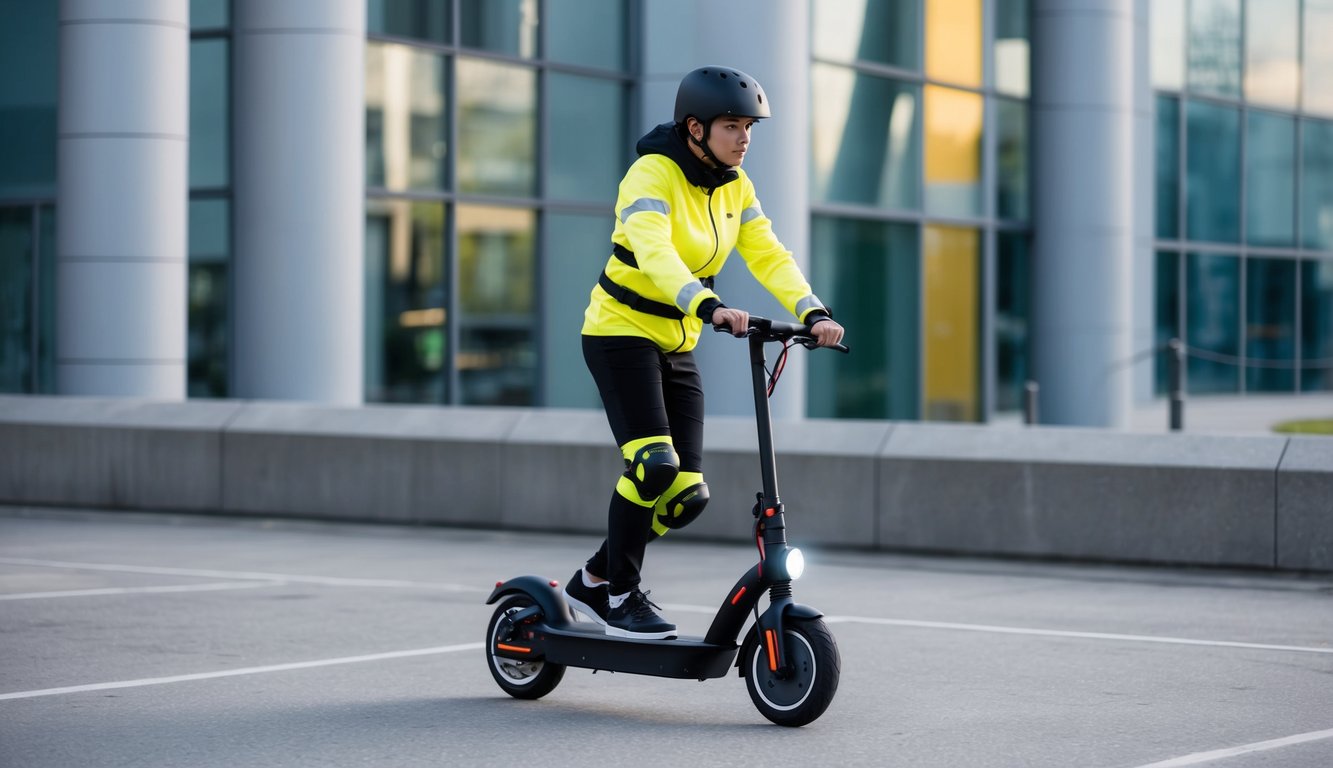
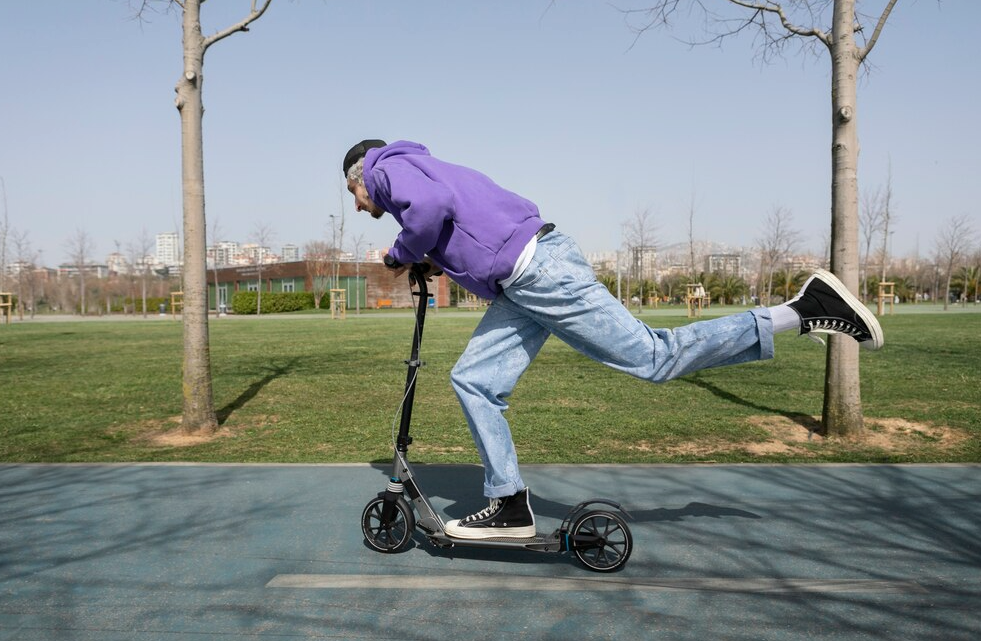


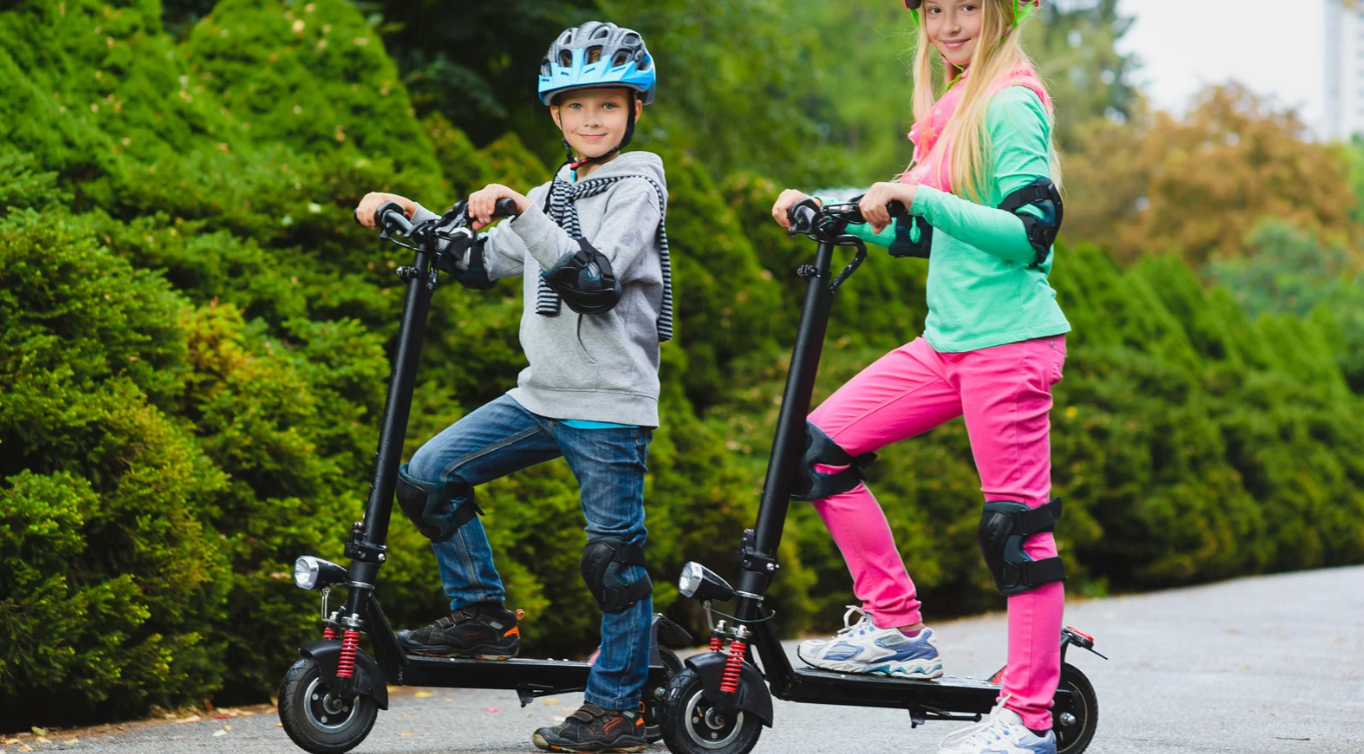
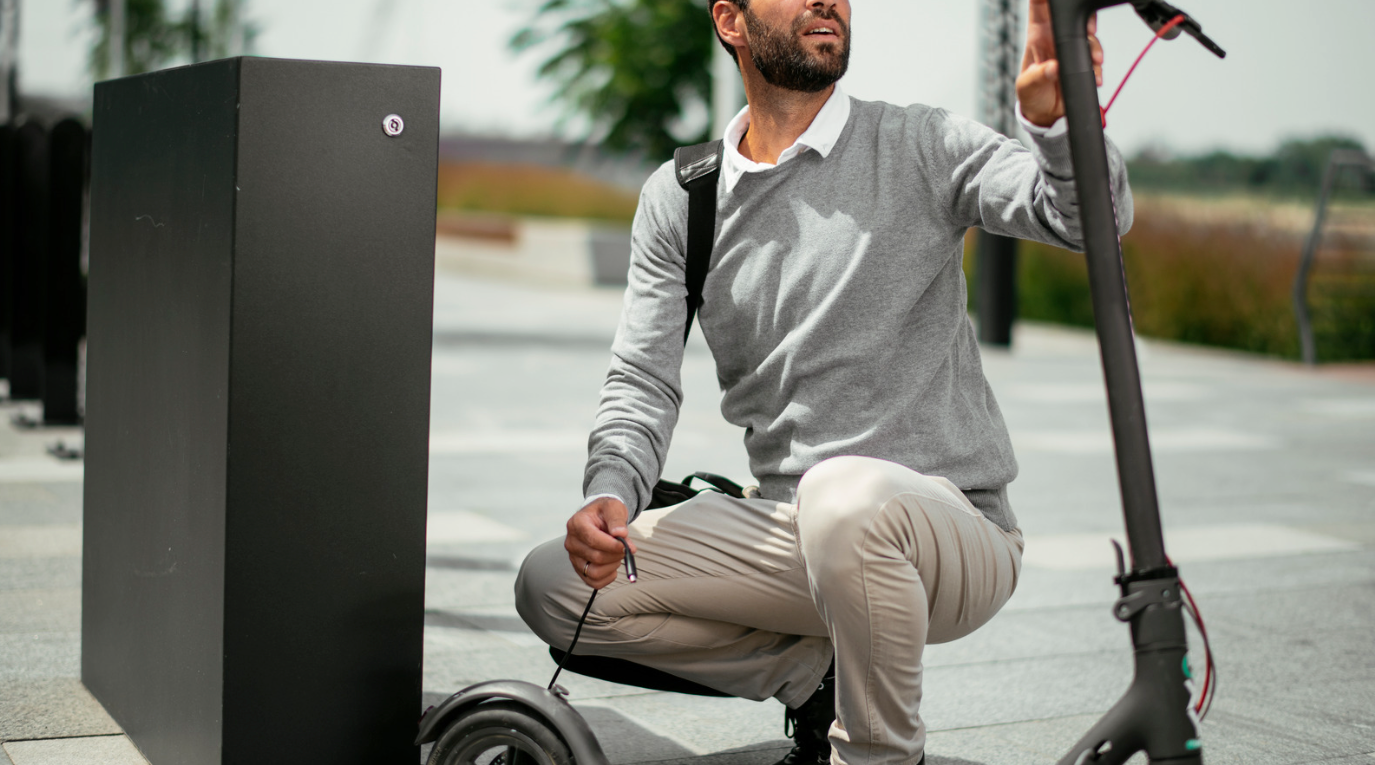
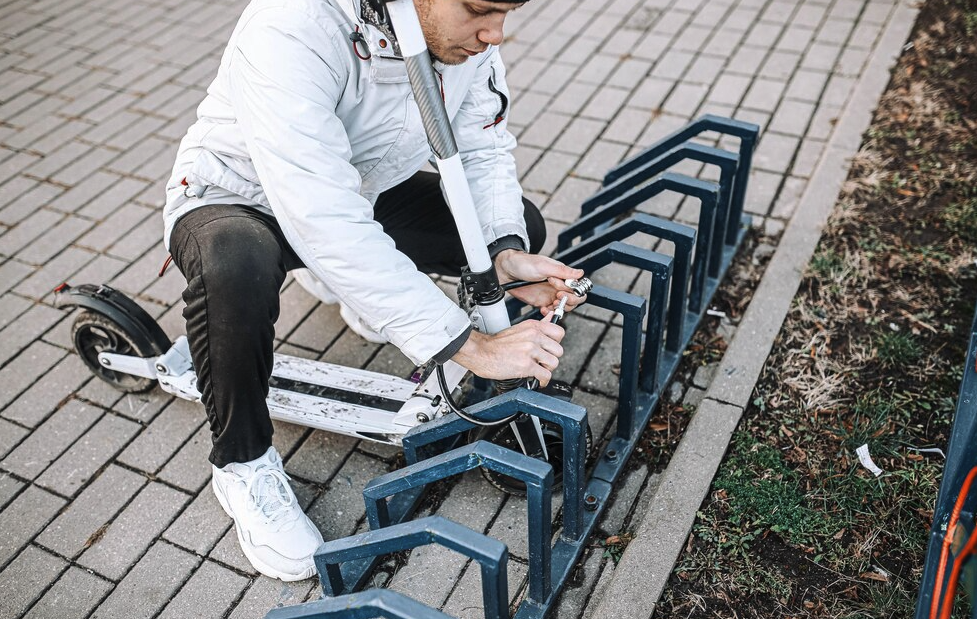


Leave a comment
All comments are moderated before being published.
This site is protected by hCaptcha and the hCaptcha Privacy Policy and Terms of Service apply.